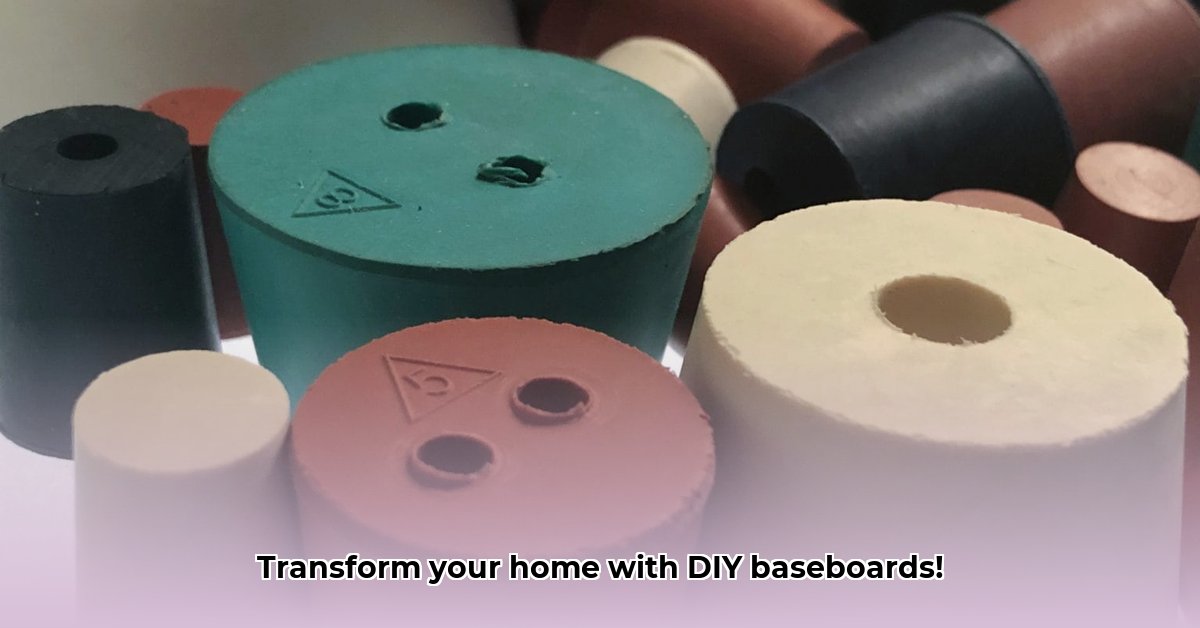Updating your home’s trim doesn’t have to break the bank or require professional help. Rubber baseboard molding offers a perfect DIY solution! This guide provides a step-by-step walkthrough for easy and affordable installation. We’ll explore how rubber compares to wood and PVC, helping you select the best option for your specific needs. With clear instructions and pro tips, you’ll confidently complete your project, giving your home a fresh, stylish upgrade. Let’s get started!
Understanding Rubber Baseboard Molding
Baseboards significantly impact a room’s overall aesthetic, yet they often go unnoticed. Rubber baseboard molding delivers a durable and surprisingly easy-to-install upgrade.
Baseboard Material Options: A Detailed Comparison
Besides rubber, consider MDF (medium-density fiberboard), PVC (polyvinyl chloride), and traditional wood. Each material has distinct advantages and disadvantages:
| Material | Advantages | Disadvantages | Moisture Resistance | Typical Cost |
|---|---|---|---|---|
| Rubber | Highly durable, excellent moisture resistance, easy to clean, flexible, resists scuffs and impacts, available in various heights and profiles. | Limited style options compared to wood, may require specific adhesives, can be more expensive than MDF. | Excellent | Moderate |
| MDF | Paintable, budget-friendly, smooth surface for painting, easy to cut and install. | Easily damaged by water, prone to swelling and warping, can chip or dent easily, not suitable for high-moisture areas. | Poor | Low |
| PVC | Water-resistant, long-lasting, resists insects and rot, available in various colors and profiles. | Can expand and contract with temperature changes, potentially causing gaps, may look less natural than wood, can be brittle in cold weather. | Good | Moderate |
| Wood | Classic look, paintable or stainable, adds warmth and character, available in a wide variety of wood species and profiles. | Susceptible to warping, rot, and insect damage, requires more maintenance, can be expensive, may require sealing or priming. | Poor | High |
For bathrooms, kitchens, or basements where moisture is a concern, rubber’s superior moisture resistance is a significant advantage. MDF might be suitable for dry areas if budget is a primary concern. However, rubber baseboards offer a lasting, low-maintenance solution for most situations.
Installing Rubber Baseboard Molding: A Comprehensive Guide
This guide provides a high-success rate for installing rubber baseboards. Remember safety first! Always wear safety glasses and work gloves.
Step 1: Preparation – The Foundation for Success
- Accurate Measurements: Measure your walls carefully. Precise measurements are crucial to avoid waste and ensure a professional finish. Double-check your measurements before cutting.
- Essential Tools: Gather these tools: measuring tape, miter saw (or hand saw), pencil, construction adhesive (specifically formulated for rubber), caulking gun, putty knife, safety glasses, work gloves, a damp cloth, and a level.
- Surface Preparation: Clean the walls thoroughly. Remove existing baseboards, nails, staples, dust, dirt, and cobwebs. Fill any holes or imperfections with spackle and sand smooth. A clean, smooth surface ensures optimal adhesive bonding.
Step 2: Cutting the Baseboards – Precision Matters
- Marking: Measure and mark the baseboards for cutting. Use a miter saw or miter box for precise angle cuts, especially for corners. For inside corners, cut a 45-degree angle with the short point on the back of the baseboard. For outside corners, cut a 45-degree angle with the short point on the face of the baseboard.
- Sharp Cutting Tools: Use a sharp blade for clean, smooth cuts. A dull blade can cause ragged edges and splintering. Replace blades as needed.
- Dry Fitting: Before applying adhesive, dry-fit all pieces to ensure proper fit and alignment. Make any necessary adjustments before proceeding.
Step 3: Applying Adhesive and Installation
- Adhesive Application: Apply a continuous, consistent bead of construction adhesive to the back of the rubber baseboard. Follow the adhesive manufacturer’s instructions for application and drying time. Ensure the adhesive is specifically designed for bonding rubber to the wall surface.
- Firm and Even Pressure: Press the baseboard firmly against the wall, ensuring full and even contact. Use a level to ensure the baseboard is straight. Maintain pressure for several seconds to allow the adhesive to grab.
- Excess Adhesive Removal: Immediately remove any excess adhesive with a putty knife and a damp cloth. Wipe the surrounding wall area to prevent adhesive residue.
Step 4: Finishing Touches – Achieving a Professional Result
- Caulking: Apply a bead of caulk along the top edge of the baseboard where it meets the wall, and along the bottom edge where it meets the floor. This creates a watertight seal and a finished look. Choose a caulk that matches the baseboard color or is paintable.
- Cure Time: Allow the adhesive and caulk to fully cure according to the manufacturer’s instructions before painting or applying any additional finishes.
Troubleshooting Common Issues
- Uneven Walls: Use shims behind the baseboard to create a consistent and level surface. Secure the shims with adhesive or small nails.
- Difficult Corners: Use a heat gun to gently warm the rubber baseboard, making it more pliable for bending around tight corners. Alternatively, consider using flexible corner pieces designed for rubber baseboards.
- Adhesive Failure: Ensure the wall and baseboard surfaces are clean, dry, and free of debris before applying adhesive. Use a high-quality construction adhesive specifically designed for rubber. Apply sufficient adhesive and maintain pressure during installation.
Post-Installation Care
Regular cleaning with a damp cloth is usually sufficient to maintain rubber baseboards. For stubborn marks, use a mild detergent and a soft cloth. Avoid abrasive cleaners, which can damage the surface.
This guide provides a comprehensive overview of rubber baseboard installation. For complex installations or large-scale projects, consider consulting a professional. Now, transform your home!
Installing Rubber Cove Baseboard in Corners: A Detailed Guide
Key Takeaways:
- Rubber cove baseboard offers excellent durability and moisture resistance.
- Proper preparation, precise cutting, and secure adhesion are vital.
- Mastering corner installation techniques elevates the final aesthetic.
- Selecting the right adhesive ensures lasting performance.
- Proactive troubleshooting prevents installation problems.
Rubber vs. Other Baseboard Materials
Understanding the differences between baseboard materials helps to inform your decision. Rubber excels in moisture resistance, making it suitable for bathrooms and kitchens.
| Material | Cost | Durability | Moisture Resistance | Aesthetic Appeal | Installation Difficulty |
|---|---|---|---|---|---|
| Rubber | Moderate | High | Excellent | Moderate | Moderate |
| Wood | High | High | Low | High | High |
| MDF | Low | Low | Low | Moderate | Low |
| PVC | Moderate | Moderate | Good | Moderate | Moderate |
Tools and Materials Checklist
Gather these supplies beforehand:
- Rubber cove baseboard (calculate the amount needed accurately)
- Construction adhesive (select a high-quality adhesive)
- Utility knife with sharp blades (for precise cuts)
- Measuring tape (for accurate measurements)
- Speed square (to ensure square cuts)
- Putty knife (for smoothing adhesive)
- Safety glasses and work gloves (for personal protection)
- Caulk (paintable caulk matching baseboard color)
- Optional: Heat gun (for softening rubber in corners)
- Optional: Miter saw (for cleaner, more precise cuts, especially for corners)
- Optional: Hot melt glue gun (for reinforcing corners)
Step-by-Step Rubber Cove Baseboard Installation
- Prepare the Walls: Ensure walls are clean, dry, and free of debris. Remove old baseboards and repair any wall imperfections.
- Precise Measurement and Cutting: Measure each wall section accurately. Use a speed square and utility knife for clean, precise cuts.
- Mastering Corner Cuts: Corner cuts require precision. For inside corners, miter the ends at a 45-degree angle, ensuring a snug fit. For outside corners, create a butt joint for a tight seam. A heat gun softens the rubber for easy bending and a smooth, finished look. Consider using hot melt glue for additional reinforcement in high-stress areas.
- Adhesive Application: Apply a thin, even bead of construction adhesive to the back of the baseboard, following the adhesive manufacturer’s guidelines.
- Secure Installation: Firmly press the baseboard against the wall, ensuring it’s straight and level. Remove any excess adhesive immediately with a putty knife.
- Caulking and Sealing: Apply caulk along the top and bottom edges of the baseboard to seal any gaps between the baseboard and the wall or floor, creating a seamless, professional finish.
- **Finishing Tou
- Kitchen tiling wall: Elevate your kitchen with stylish wall tiles - December 16, 2025
- Gray Kitchen Backsplash Tile: Ideas for a Stylish Upgrade - December 14, 2025
- Backsplash For Gray Cabinets: Choosing the Right Backsplash Style - December 13, 2025









